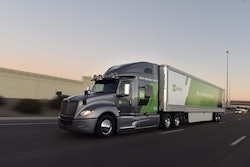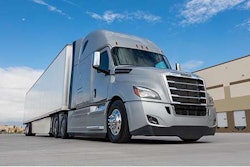
Old Man Winter isn’t showing any signs of slowing down. Plenty of snow is still in the forecast today and throughout the weekend across the U.S.
Of course, fleet preparation is key. FedEx and PetroChoice weighed in on how they’re taking on snow, ice and freezing conditions in the Q&A below.
HWT: How do you prepare your drivers and fleet during extremely cold weather?
FedEx: FedEx has an in-house meteorology department that is responsible for monitoring weather trends around the globe. The staff of 15 meteorologists is frequently called on for weather briefings for high-impact events to assist in protecting the corporation’s people, assets and brand.
HWT: Several private and public entities shut down their fleets recently during historically cold weather. What are some of the factors that are considered prior to suspending fleet operations?
FedEx: FedEx will put contingency plans in place to ensure the well-being of our team members and service providers and to lessen the weather’s impact on service. While some operations and service may be affected during extreme winter weather, our priority is always safety and providing service to the best of our ability.
HWT: Generally speaking, how much of an impact do winter events have on fleet business compared to other weather events such as heat waves, tornadoes, dust storms, rain storms and hurricanes?
FedEx: Every weather event has its own challenges, but safety is always our top priority. We rely on information from our meteorologists along with local operations to ensure our drivers are able to move safely on the road.
HWT: What are some recommended steps for winterizing a fleet?
FedEx: We have a rather diverse fleet and there isn’t one way to winterize the various vehicles. Proper maintenance is the early first step, and in weather like this ensuring we have snow tires installed for local conditions. We follow manufacturers recommendations, and have policies in place to ensure that our fleet is prepared to face the weather in each market area.
HWT: White-outs and icy roads have already caused quite a few problems for fleets this winter. What are some recommended strategies in dealing with tough winter driving conditions?
FedEx: Colder temperatures often result in snow and ice conditions and these create new hazards when driving and operating equipment. To safely work in these conditions, FedEx team members must stay focused and continue to be proactive. Recommended strategies include:
- Watch For Black Ice: Black ice can sneak up on you. When the temperature gets close to freezing, look for these clues:
-
-
- Ice build-up on mirror arms, antenna, or the top corners of the windshield.
- Spray from tires on vehicles in front of you disappears.
-
- Adjusting Stopping Distances: Give yourself an extra space cushion and slow down.
- Braking while turning: When driving in the snow, do everything slowly – driving can be treacherous. In the snow, the tires are always just barely grabbing the road. Accelerate slowly, turn slowly, and brake slowly and gently. To do this, you have to anticipate turns and stops.
- Climbing and Descending Hills: Reduce your speed and be especially cautious on hills and curves.
PetroChoice’s tips for taking on Old Man Winter
HWT: How do you prepare your drivers and fleet during extremely cold weather?
PetroChoice: In winter weather conditions, it’s even more important for drivers to keep safe following distances behind other motorists. It’s also critical that before any haul, there is a mandatory checklist and inspection that takes place. This inspection can include things like checking fuel levels, windshield wiper fluid levels, keeping taillights and windshields clear, heaters and defrosters are working. Drivers should also have things like a change of clothing, blanket, gloves, a flashlight and extra water before hitting the road.
HWT: Several private and public entities shut down their fleets recently during historically cold weather. What are some of the factors that are considered prior to suspending fleet operations?
PetroChoice: We do monthly trainings with drivers and more frequently during the winter months so they are ready for inclement winter weather beforehand. The topics covered in these trainings are reinforced throughout the year in a variety of ways. We also pre-plan with drivers as much as possible according to the weather. Driver safety is our top priority so if we know the weather is going to be bad, we plan as many days in advance as possible, however if the weather doesn’t let up and allow for safe driving conditions, we suspend operations. It’s critical to coordinate with customers who are expecting product to set the expectations that product may not arrive if conditions are as bad as expected. Oftentimes, the customers experience the same conditions and we work out a convenient time for delivery.
HWT: Generally speaking, how much of an impact do winter events have on fleet business compared to other weather events such as heat waves, tornadoes, dust storms, rain storms and hurricanes?
PetroChoice: Winter weather can leave roads torn up for weeks, between ice, pot holes and snow, among other things. You basically have an entire season where bad weather should be expected, versus seasons where bad weather is possible. It doesn’t always have to have a large impact on business so long as fleets plan ahead and keep an open line of communication with customers.
HWT: White-outs and icy roads have already caused quite a few problems for fleets this winter. What are some recommended strategies in dealing with tough winter driving conditions?
PetroChoice: In low visibility situations, it is recommended that drivers have a safe following distance behind other motorists. It’s also important to consider the type of cargo being carried. For example, our fleets are carrying fuel and lubricants. This can affect the weight of the truck and how easily the trucks carriage can be spun out, which is why safe following distances and lower speeds are the best strategy for trucks to avoid issues on their haul.
HWT: What are some recommended steps for winterizing a fleet?
PetroChoice: It’s always advised that if visibility is minimal, find the nearest truck stop and pull over there. There are two parts to winterizing a fleet, one being vehicle maintenance and the second being driver preparedness. In terms of vehicle maintenance, check fuel levels, windshield wiper fluid levels, heaters, defrosters and battery charge. Drivers and fleet owners should work together conducting frequent maintenance checks, paying especially close attention to how brakes are working and tire traction. In terms of preparing drivers, go over safety precautions and checklists for driving in winter weather. Repetition of safety precautions and presenting them to drivers in different ways based on their learning style is important to make sure safe behavior becomes habit. Consider quizzing drivers on safety standards to make certain they know them
HWT: Please list any weather-related apps or telematics features that your fleet has found useful in dealing with inclement weather.
PetroChoice: All of our drivers are equipped with company-provided iPhones to facilitate seamless and immediate communication between dispatchers and managers when at a stop. We don’t want to complicate the process further by adding too many apps or other features to the equation for drivers. It’s up to managers and dispatchers to stay updated on weather conditions and communicate that to their drivers.












